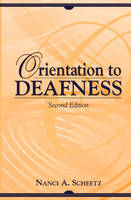
Orientation to Deafness
Pearson (Verlag)
978-0-205-32801-7 (ISBN)
- Titel ist leider vergriffen;
keine Neuauflage - Artikel merken
This unique sourcebook provides a comprehensive overview of the field of deafness and the development of deaf individuals from birth through adulthood.
Not only does the text focus on educational perspectives, psychosocial precepts, communication modes, vocational opportunities, support services, and recent technological advances, it provides the reader with insights into one of the fastest growing populations today — the deafened adult. Orientation to Deafness provides insights into the psychosocial development of Deaf children of Deaf parents, as well as deaf children of hearing parents. Throughout the chapters, myths surrounding deafness are dispelled and the salient characteristics of Deaf culture that lie at the heart of the Deaf community are examined. Special attention is given to the anatomy and physiology of the hearing mechanism, and recent advances in hearing aids, modern technology, and an annotated list of support services are provided.
The broad scope of subject matter presented allows for flexibility and provides fresh material for new approaches to basic courses within the field of deaf education. This excellent introductory text is also a teaching-learning vehicle — basic concepts and illustrations are repeated in different contexts to promote comprehension and enhance retention. Designed as a source book on the many dimensions of deafness, Orientation to Deafness is dedicated to providing a panoramic view of a complex field rather than an in-depth analysis of each major dimension.
All chapters conclude with “Summary.”
1.A Psychological Perspective of Deafness.
Outside the Deaf World: A Hearing Perspective of the Disability. Impact of Deafness on Psychosocial Development: Relating to Those around Us. A Look at Erikson's Developmental Model as It Applies to Deafness. The Deaf Culture.
2.The Art of Hearing.
The Propagation of Sound. The External Ear. The Middle Ear. The Inner Ear. The Physiology of Hearing. Causes of Auditory Dysfunction. Audiological Evaluation.
3.Family Dynamics.
Reflections on Having a Deaf Son: One Father's Perspective. Dealing with the Diagnosis of Deafness.
4.The Educational Environment.
Modes of Communication. Educational Environments for Deaf Children. Special Schools. Regular Education Programs. Residential School Placement. Deaf Students Mainstreamed into Public Schools. Effect of Language Acquisition and Development. Spoken Language Development. Post-Secondary Educational Settings. Post-Secondary Programs for the Hearing Impaired in the United States.
5.Modes of Communication.
Components of the Communication System. History of American Sign Language. Pidgin Sign English (PSE) — A Language Bridging the Gap. Manually Coded English Systems. Rochester Method. Total Communication. Oral Communication. Cued Speech. Written Forms of Communication: Language-Teaching Systems. Written Communication Samples — A Look at Deaf Adults Today.
6.The Art of Reading.
Learning to Read. Bottom Up Models. Top Down Models. Interactive Models. Impact of Deafness on Reading Development. Strategies for Enhancing Reading through a Multisensory Approach. Applying Principles for Reading to the Classroom.
7.Cognition and Intellectual Functioning.
Theories of Cognitive Development. Effects of Deafness on Cognitive Development. Intelligence Testing. Intellectual Testing and Deafness. Administering Intelligence Tests to Deaf Individuals.
8.Moral Reasoning and Values Clarification.
Developing a Moral Code. A Structural-Developmental Theory of Moral Development. The Impact of Deafness on Moral Development. Assessing Levels of Moral Reasoning in Hearing Impaired Individuals. Liberation from Adult Constraints: Impact of Parental Discipline Techniques. The Use of Discipline and the Methods of Communication. Additional Insights into Deafness and Moral Development. Social Learning and Values Clarification. Deafness, Social Learning, and Values Clarification.
9.The Deafened Adult.
Characteristics of Older Adults. Physiological Changes Due to the Aging Process. Communication Issues Relevant to the Deafened Adult. A Psychosocial Perspective of Deafness throughout the Senior Years. Rehabilitation for the Deafened Adult. Support Groups for the Deafened Adult.
10.Myths and Misconceptions.
Deaf People Can't Hear Anything. Myths Surrounding the Causes of Hearing Loss. All Deaf People Can Read Lips. Can Deaf People Read? Deaf People Can't Talk. All Deaf Children Have Deaf Parents. Deaf Children Can't Attend School. Hearing Aids Enable Deaf People to Hear Speech. All Deaf People Wish They Could Hear. Deaf People Are Not as Intelligent as Hearing People. Deaf People Can't Drive. Deaf Individuals Have More Serious Emotional Problems Than Hearing People. Deaf People Can't Work. All Deaf People Know Sign language. Deaf People Are Very Quiet.
11.Deafness and the World of Work.
Barriers to Employment. Vocational Development, Assessment, and Career Exploration. Vocational Rehabilitation. Employment. Underemployment. Vocational Opportunities for Minorities and Multi-Handicapped Deaf Individuals. Future Employment Trends.
12.Deaf Individuals with Special Needs.
Prevalence of Additional Condition. Deaf and Hard-of-Hearing Children with Special Needs: Cognitive/Intellectual Conditions. Educational Personnel Serving the Deaf/Mentally Disabled Child. Physical Conditions.
13.Hearing Aids and Modern Technology.
The Hearing Evaluation. The Function and Components of Hearing Aids. Types of Hearing Aids. Hearing Aid Orientation. Group Listening Systems. Individual Amplification Systems. Additional Devices for Individuals with Hearing Impairments.
14.Support Services.
Support Personnel. Organizations and Agencies. Deaf Service Centers. Technical Aids: Special Equipment and Products. Telecommunication Devices (DDS).
| Erscheint lt. Verlag | 20.12.2001 |
|---|---|
| Sprache | englisch |
| Maße | 152 x 229 mm |
| Gewicht | 562 g |
| Themenwelt | Sachbuch/Ratgeber ► Gesundheit / Leben / Psychologie ► Lebenshilfe / Lebensführung |
| Medizin / Pharmazie ► Medizinische Fachgebiete ► HNO-Heilkunde | |
| ISBN-10 | 0-205-32801-6 / 0205328016 |
| ISBN-13 | 978-0-205-32801-7 / 9780205328017 |
| Zustand | Neuware |
| Informationen gemäß Produktsicherheitsverordnung (GPSR) | |
| Haben Sie eine Frage zum Produkt? |
aus dem Bereich


